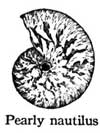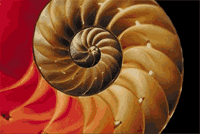|
Living fossils: Having survived relatively unchanged
during millions of years, nautiluses represent the only living
members of the subclass Nautiloidea, and are often considered
to be "living fossils".

 No suckers, many tentactles, nine teeth: The nautilus is similar in general form to other cephalopods,
with a prominent head and tentacles. Nautiluses typically have
more tentacles than other cephalpods, up to ninety. These tentacles
are arranged into two circles and, unlike the tentacles of other
cephalopods, they have no suckers, are undifferentiated and retractable.
The radula is wide and distinctively has nine teeth. There are
two pairs of gills. No suckers, many tentactles, nine teeth: The nautilus is similar in general form to other cephalopods,
with a prominent head and tentacles. Nautiluses typically have
more tentacles than other cephalpods, up to ninety. These tentacles
are arranged into two circles and, unlike the tentacles of other
cephalopods, they have no suckers, are undifferentiated and retractable.
The radula is wide and distinctively has nine teeth. There are
two pairs of gills.
The largest adults can reach 220 mm in diameter.

 Pearly insides: Nautiluses are the sole cephalopods whose bony structure of the
body is externalized as a shell. The animal can withdraw completely
into its shell, closing the opening with a leathery hood formed
from two specially folded tentacles. The shell is coiled, calcareous,
mother-of-pearl-lined and pressure resistant (imploding at a depth
of about 800 m). The nautilus shell is composed of 2 layers: the
outer layer is a matte white, while the inner layer is a striking
white with iridescence. The innermost portion of the shell is
pearlescent, blue-gray. The Pearly insides: Nautiluses are the sole cephalopods whose bony structure of the
body is externalized as a shell. The animal can withdraw completely
into its shell, closing the opening with a leathery hood formed
from two specially folded tentacles. The shell is coiled, calcareous,
mother-of-pearl-lined and pressure resistant (imploding at a depth
of about 800 m). The nautilus shell is composed of 2 layers: the
outer layer is a matte white, while the inner layer is a striking
white with iridescence. The innermost portion of the shell is
pearlescent, blue-gray. The  osmena pearl, contrarily to its name,
is not a pearl, but a jewelry product derived from this part of
the shell. osmena pearl, contrarily to its name,
is not a pearl, but a jewelry product derived from this part of
the shell.
Chambers in the shell: The shell is internally divided into chambers, the chambered
section being called the phragmocone. The phragmocone is divided
into camerae by septa, all of which are pierced in the middle
by a duct, the siphuncle. As the nautilus matures its body moves
forward, sealing the camerae behind it with a new septum. The last
fully open chamber, also the largest one, is used as the living
chamber. The number of camerae increases from around four at the
moment of hatching to thirty or more in adults.
 Cryptic coloring: The shell coloration also keeps the animal cryptic in the water.
When seen from the top, the shell is darker in color and marked
with irregular stripes, which makes it blend into the darkness
of the water below. On the contrary, the underside is almost completely
white, making the animal indistinguishable from brighter waters
near the ocean surface. This mode of camouflage is named countershading. Cryptic coloring: The shell coloration also keeps the animal cryptic in the water.
When seen from the top, the shell is darker in color and marked
with irregular stripes, which makes it blend into the darkness
of the water below. On the contrary, the underside is almost completely
white, making the animal indistinguishable from brighter waters
near the ocean surface. This mode of camouflage is named countershading.
One of the finest natural logarithmic spiral: The nautilus shell presents one of the finest natural examples
of a logarithmic spiral. (It is sometimes incorrectly claimed
to be a golden spiral as well.)
 Jet propulsion: In order to swim, the nautilus draws water into and out of the
living chamber with the hyponome, which makes use of jet propulsion.
When water is inside the chamber, the siphuncle extracts salt
from it and diffuses it into the blood. When water is pumped out,
the animal adjusts it buoyancy with the gas contained in the chamber.
Buoyancy can be controlled by the osmotical pumping of gas and
fluid into or from the camerae along the siphuncles. The control
of buoyancy in this manner limits the nautilus; they cannot operate
under extreme hydrostatic pressures. Jet propulsion: In order to swim, the nautilus draws water into and out of the
living chamber with the hyponome, which makes use of jet propulsion.
When water is inside the chamber, the siphuncle extracts salt
from it and diffuses it into the blood. When water is pumped out,
the animal adjusts it buoyancy with the gas contained in the chamber.
Buoyancy can be controlled by the osmotical pumping of gas and
fluid into or from the camerae along the siphuncles. The control
of buoyancy in this manner limits the nautilus; they cannot operate
under extreme hydrostatic pressures.
 The animal can also crawl on land or on the seabed. The animal can also crawl on land or on the seabed.
In the wild nautiluses usually inhabit depths of about 600-800
m, rising to around 200 m at night for feeding, mating and egg
laying.
Tentacle capture: Nautiluses are predators and feed mainly on shrimps, small fish
and crustaceans, which are captured by the tentacles. Unlike other
cephalopods, they do not have good vision; their eye structure
is highly developed but lacks a solid lens. They have a simple
"pinhole" lens through which water can pass. Instead
of vision, the animal is thought to use olfaction as the primary
sensory means during foraging, locating or identifying sexual
partner.

12 month development: Nautiluses are sexually dimorphic and reproduce by laying eggs.
Attached to rocks in shallow waters, the eggs take twelve months
to develop before hatching out at around 30 mm long. The lifespan
of nautiluses is about 20 years, which is exceptionally long for
a cephalopod.
All text is available under the
terms of the GNU Free Documentation License
|